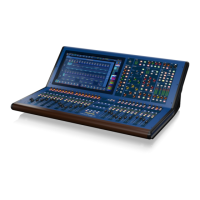144 HD96-24-CC-TP User Manual
Ambience Reverb
The ambience reverb adds warmth and depth to source material without adding the obvious artefacts commonly associated with articial reverbs. It simulates
smaller rooms using diused early reections with the additional exibility of separate reverb tail level and decay control. Reective surface materials and air
absorption properties can be simulated by adjusting the high and low frequency cut amount and high frequency damping.
Item Control Function
1 IN level meter
INPUT meters, which comprise a dual-column peak reading LED meters. Each column consists of 14 coloured LEDs. The red LED
illuminates at 3 dB before the clipping point.
2 Pre Delay control Controls the amount of delay (in milliseconds) between the initial signal and the onset of reverberation.
3 Size control
Adjusts the average dimension of the simulated space. Range is from 0% to 100% of the largest space possible. A momentary
mute is implemented when this control is adjusted.
4 Decay control Control that sets the overall (mid-band) reverberation decay time. Range is from 0.5 to 10 seconds, depending on room size.
5 Audition button A sample is triggered to test reverb characteristic.
6 LF Cut control Control that adjusts the Low Frequency cut from 10 Hz to 500 Hz.
7 HF Cut control Control that adjusts the High Frequency cut from 0.2 kHz to 20 kHz
8 HF Damp Dampens the HF to produce a darker sounding reverb. Settings from 1 kHz to 20 kHz
9 Diusion control
Reducing diusion creates more discrete echoes, for vocals and other sustained sounds, reduced diusion can give smooth
reverberation that doesn’t overpower the source and maintains clarity.
10 Modulation control To create more variation in reverb sounds, modulation adds subtle changes to the reverb characteristics.
11 Power button Turns on the Reverb eect.
12 Tail Gain control Used to reduced the level of the reverb tail from 0 dB to -inf dB
13 MIX control Controls the DRY/WET output mix and ranges from 0% to 100%, respectively.
14 OUT Level meter
OUTPUT meters, which comprise a dual-column peak reading LED meters, ranging from-30 dB to 18 dB. The red LED illuminates
at 3 dB before the clipping point, which also provides an over-range warning for the arithmetical processor.

